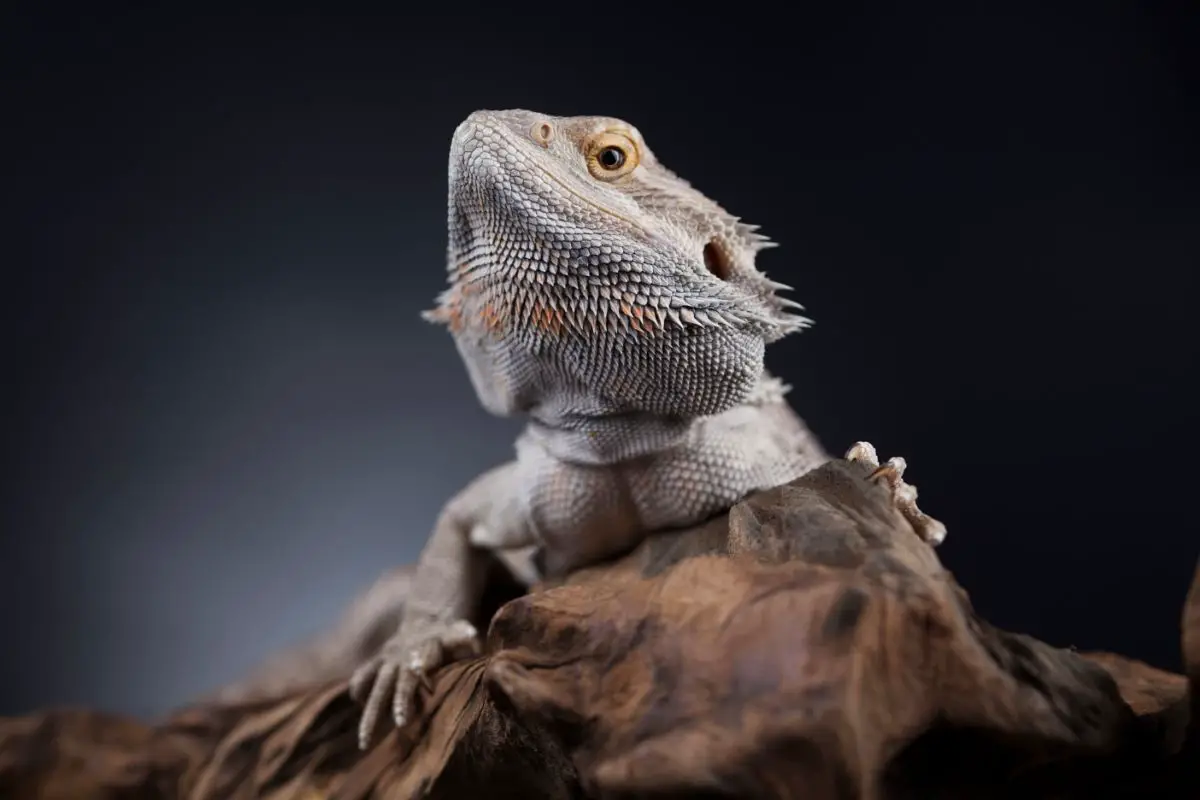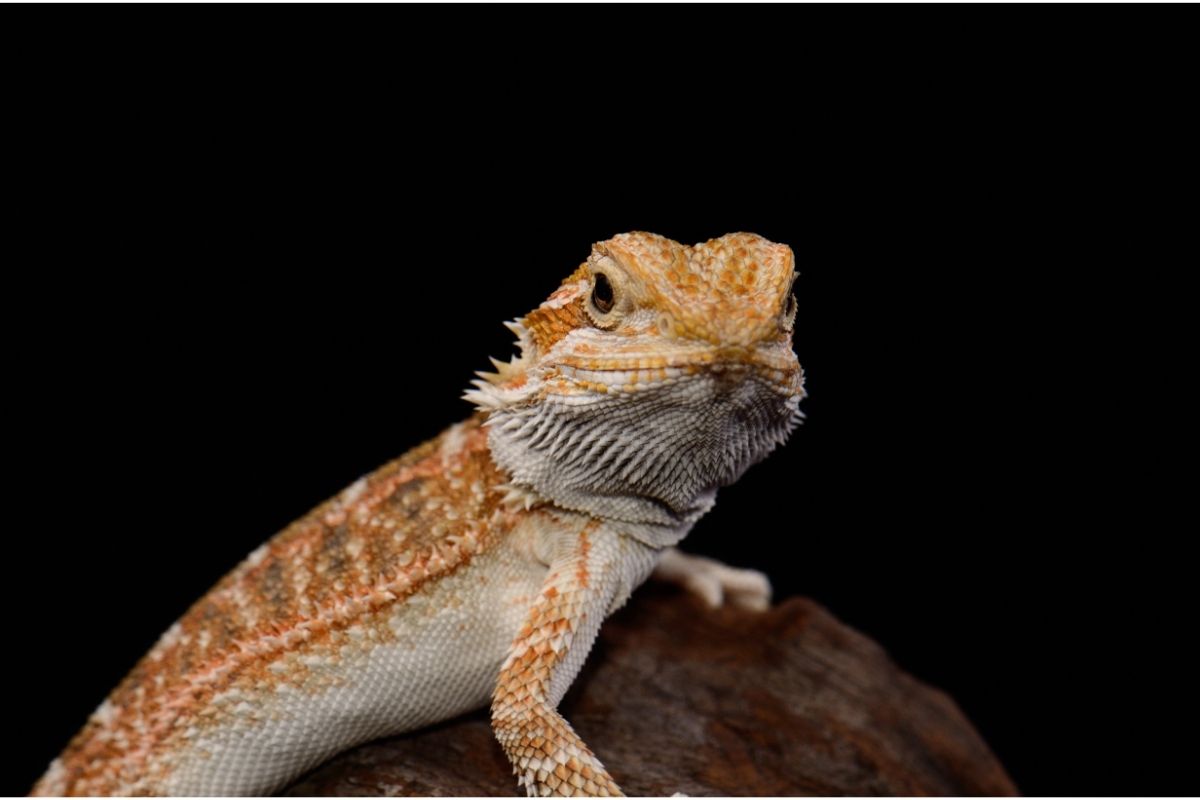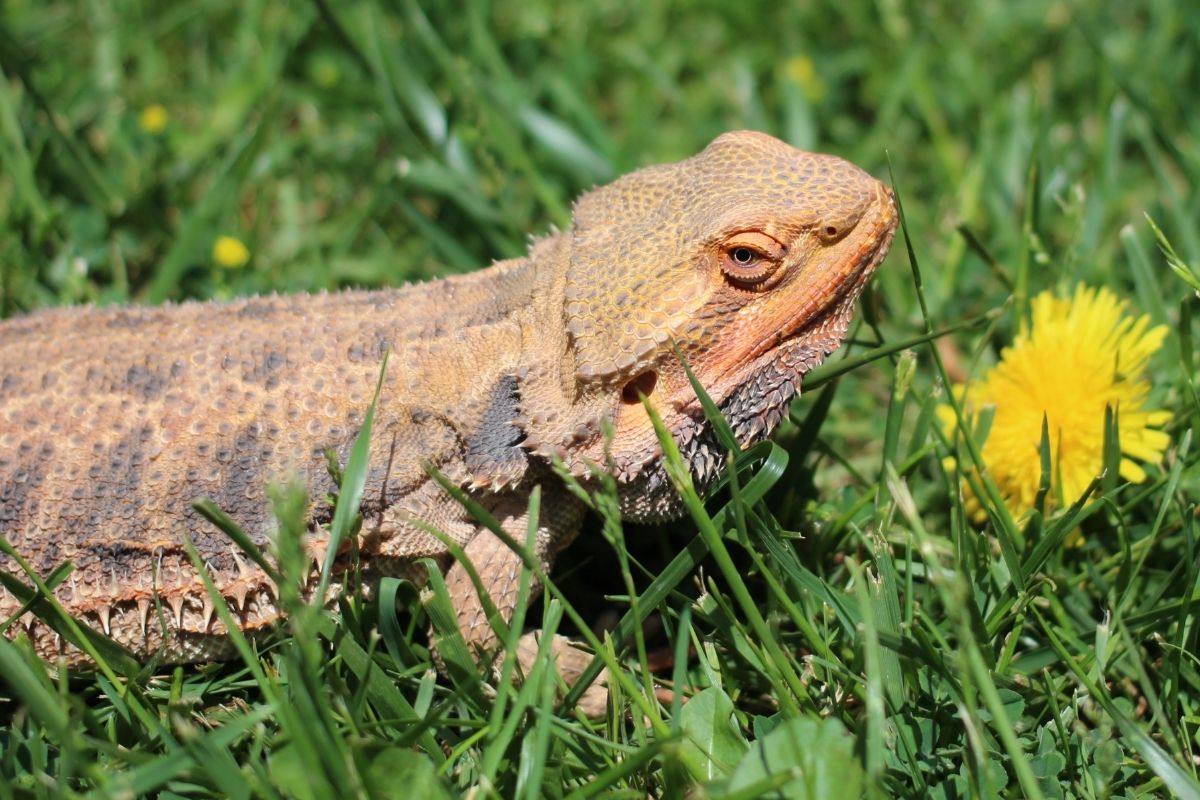Bearded dragons are one of the most popular reptile pets in the United States today. They’re easy to care for, extremely docile, and quite affordable.
It’s no wonder why there is such an abundance of them in pet stores across America.

Some people even consider them an ideal family pet because they’re so friendly and non-aggressive.
However, it should be noted that just like any other species of lizard, they can grow at different rates depending on their age, diet, and environmental conditions.
In this article, we will take a look at how big a bearded dragon can get after 12 months old. We’ll also discuss how fast they grow as well as what you should feed your bearded dragon.
So, let’s get started!
How Big Will A Bearded Dragon Get After 12 Months?
After about six months, the bearded dragon starts to develop its adult size.
This means that if you have a baby bearded dragon now, he or she will reach full-grown size within another six to eight weeks.
The average length of a fully developed beardie is nine inches long. However, not all of them grow bigger than that.
So, before deciding whether to buy a bearded dragon, make sure to check out the size of the animal.
The first thing you need to know is that a male beardie grows much faster than a female.
A female usually reaches full adulthood around ten to thirteen months, while a male does it much sooner. He could be ready to mate by four to five months of age.
However, keep in mind that these things vary from individual to individual.
Some males don’t mature until they’re eighteen months old, while others might still be growing into their adult size at two years old.
Below are bullet points indicating how big a bearded dragon typically is at various ages.
- Zero to One Month – A bearded dragon at this stage is still a baby and should be between three and four inches in size.
- Two Months – At this stage, a bearded dragon is still an infant, but it should be larger than the zero to one month stage. On average, a two-month-old bearded dragon should be between five and nine inches long.
- Three Months – Bearded dragons are still considered babies at this stage. But it should have grown since the previous two stages. In general, a three-month-old bearded dragon should be between eight and eleven inches long.
- Four Months – A bearded dragon is considered a baby at this stage, and they should be between nine and twelve inches long overall at this point in their life.
- Five Months – Bearded dragons are still considered babies at this point, they should be between eleven and sixteen inches long
- Six Months – At this age, a bearded dragon is considered a juvenile and should be between eleven and eighteen inches in length.
- Eight Months – A bearded dragon is considered a juvenile, and it should be between thirteen and twenty inches long.
- Twelve Months – At a year of age, a bearded dragon finally entered adulthood and should be between sixteen and twenty-two inches in length.
- Twenty-Four Months – At two years old, a bearded dragon is well and truly an adult and should be anywhere between eighteen and twenty-four inches long.
At What Point Will A Bearded Dragon Reach Its Full Size?
As mentioned above, most of them start to show signs of maturing around six months of age. As soon as they start to develop their spines, the dragon can start to grow longer.
They typically stop growing once they reach about seven feet long and weigh around 50 pounds.
Some bearded dragons grow much slower than others. If you want to find out when your new bearded dragon will reach his or her full size, you need to consider their diet.
If your bearded dragon eats more food, it will grow faster. And if it only consumes less food, it will grow slower.
Therefore, you must ensure that you give your bearded dragon enough food to meet its nutritional needs.
Another factor that may affect the growth rate is genetics.
Since many bearded dragons come from breeders who do not use genetic sexing techniques, there is a high chance that both sexes were kept together as hatchlings.
This means that each bearded dragon has the same genes and can, therefore, potentially grow at the same pace.
In order to determine how fast your bearded dragon will grow, you first need to know how large he or she will be after reaching maturity.
In the next section, we are going to look at several species of bearded dragons and how big you can expect them to grow.
How Big Do Different Bearded Dragon Species Grow?
You may be surprised to learn that there are actually several species of bearded dragons out there, and some varieties will grow larger or smaller than others.
So, let us take a look at what you can expect to see when these bearded dragons reach maturity.
- Drysdale River Bearded Dragon – This variety of bearded dragon can grow up to between four and six inches long and also goes by the name pogona microlepidota.
- Dwarf Bearded Dragon – This variety of bearded dragon is also known as the pogona minor minima, and it can grow up to between nine and twelve inches long.
- Mitchells Bearded Dragon – This species is also known as pogona minor mitchelli and grows up to between fourteen and eighteen inches in length.
- Rankins Bearded Dragon – Also known as the pogona henrylawsoni, this bearded dragon can grow up to between nine and twelve inches long.
- Coastal Bearded Dragon – Also known as pogona barbata, this species of bearded dragon should grow to between twenty and twenty-four inches long.
- Western Bearded Dragon – This species grows up to between fourteen and eighteen inches in length and is also known as pogona minor.
- Central Bearded Dragon – This species, also known as pogona vitticeps should grow between twenty and twenty-four inches long.
- Nullarbor Bearded Dragon – This variety of bearded dragon is also known as the pogona nullabor, and it can grow up to between eleven and fourteen inches long.
Is Your Bearded Dragon An Adult, Juvenile Or Baby?
Bearded dragons are typically considered adults at around one year old.
However, it is important for you to understand the differences between adults, juveniles and baby dragons.
So, let us take a look at what you can expect your bearded dragon to look and act like in these categories.
Baby Bearded Dragons
A beardie that is between zero and six months old is considered a hatchling or baby. It is when they are this young that you can expect the most growth to occur.
This is why it is extremely essential to make sure that your baby beardie gets the right nutrients, food and environment.
A lack of these things can stunt your baby bearded dragon’s growth so make sure to do your research and have everything set up correctly before you bring your new pet home.
Juvenile Bearded Dragons
Your juvenile bearded dragon will continue growing until approximately two years old, when they become fully mature.
But they are considered juveniles from six months to one year of age, after which they are, obviously, considered adults.
When they are younger, they tend to be more active and playful than their adult counterparts.
They will still eat the same type of diet, but they will eat more frequently. You can expect to see weight gain during this time period.
Adult Bearded Dragons
As your bearded dragon grows older, they will start losing weight. This means that they need to be fed less often, and they will begin eating less overall.
Their metabolism slows down, and they will not require as much energy as they did when they were younger.
Your bearded dragon will continue to grow taller, but they will no longer grow as fast as they once did.
What Causes A Bearded Dragon’s Growth To Become Stunted?

There are many reasons why a bearded dragon may stop growing.
Some of them include: poor nutrition, such as a lack of protein, calcium, and vitamin D; insufficient space to move around; being kept in very small enclosures; and being left without enough light exposure.
All of these issues can cause stunting in your bearded dragon’s growth.
If you notice that your bearded dragon is showing signs of stunting, then it is best to seek out some professional help.
Below is a list of the most common reasons your bearded dragon may not be growing properly.
- They may have an issue with the lighting or other aspects of their environment, which can cause them not to grow as they should.
- If they are not given enough food, too much food, or are not given food that is suited to bearded dragons in general.
- If you allow your bearded dragon to brumate when they are too young, it can cause them not to grow to the size they should.
- If the temperature in your bearded dragon’s enclosure is not good, it can cause them not to grow as much as they should.
Now that we know about these four main reasons let us look at them in a little more depth.
Lighting And Environment
The first thing that we must consider is the amount of light that your bearded dragon receives. There are different types of lights that you can use for bearded dragons.
These lights vary in terms of how bright they are and what color spectrum they emit. The best option would be a full-spectrum fluorescent bulb.
This is because it emits both white light and blue light, which are essential for proper development.
Other options include incandescent bulbs, compact fluorescent bulbs (CFL), and LED lights. Each of these has its own advantages and disadvantages.
However, all of them emit light over a wide range of wavelengths. So if you choose to go with any of these lights, make sure that you research each option carefully.
Another factor that needs to be taken into consideration is the quality of the air in your bearded dragon’s enclosure.
If there is a lot of dust, pollen, mold spores, and fungus floating around, then this could be affecting your bearded dragon’s growth negatively.
It is important to clean up regularly so that you do not end up with an infestation of pests or parasites.
Your Dragon Is Not Getting A Proper Diet
When choosing a diet for your bearded dragon, you need to ensure that it is appropriate for their age. You should also take into account what type of foods they like or dislike.
For example, if your bearded dragon likes the taste of meat, then you should feed them meat every day.
But if they prefer fruit and vegetables, then you should only give them those items on alternate days.
A balanced diet will provide your bearded dragon with everything that they need to thrive.
They should receive adequate amounts of vitamins and minerals, proteins, fats, carbohydrates, and water.
Most of all, it is critical that your bearded dragon receives enough calcium and vitamin D in order to develop strong bones and teeth.
In addition to providing your bearded dragon with a healthy diet, you should also keep an eye on their activity levels.
When they are inactive, they may not be getting enough exercise. This means that they might not be growing properly.
So you need to find ways to stimulate their movement by making sure that you have toys, logs, rocks, branches, etc., available for them to climb on.
Brumation Too Early In Their Life
Youngsters who are kept in captivity often experience problems with growth due to being held back before they are ready.
In some cases, this can lead to stunted growth because they never quite get the chance to reach their potential size.
Sometimes, this issue occurs even if the owner thinks that the snake is old enough to handle larger prey.
If this happens, then it is likely that the reptile was originally purchased as a hatchling from the pet store.
These young snakes are usually tiny when they arrive at the store. Therefore, they grow out of proportion very quickly and become too large for their environment.
The Temperature Of Their Environment
Keeping your bearded dragon indoors can be a great way to protect them from extreme temperatures.
However, this does mean that they cannot enjoy the benefits that come with living outdoors.
In fact, if you live in a cold climate, then you shouldn’t expect your bearded dragon to survive outside.
If you live somewhere where the temperature drops below freezing, then you should not expose your bearded dragon to the elements.
Instead, place them inside during the winter months.
If you want to make sure that your bearded dragon survives through the colder seasons, then you should consider purchasing heat lamps.
Heat lamps use infrared radiation to warm up objects such as plants, fish tanks, turtles and lizards.
There are many types of heat lamp options available, so you should purchase one that best suits your needs.
Your bearded dragon’s enclosure should also contain a basking spot. Basking spots work by emitting infrared rays which create warmth that helps keep reptiles comfortable.
It is important that you maintain a constant level of ambient light in your bearded dragon’s habitat. This will help regulate their body temperature.
If your bearded dragon has been exposed to extreme temperatures over time, then you should try to raise its internal temperature gradually.
For example, you could start by placing them in a cool room for about 30 minutes daily.
Once they no longer appear to be uncomfortable while there, then you can increase the amount of time that they spend in the cooler conditions.
Your Dragon May Have Health Issues
It is possible for your bearded dragon to develop health issues if they do not receive proper medical attention.
For instance, they might suffer from a respiratory infection or a fungal disease.
You should take your lizard to see a veterinarian if any of these symptoms occur. Also, your bearded dragon might have other health issues if they don’t eat well.
Make sure that your reptile receives regular feeding schedules. They should have fresh fruits, vegetables, and meat every day.
How To Get UVB Exposure Right For Bearded Dragons?

It is essential that your bearded dragon gets sufficient ultraviolet (UV) exposure in order to stay healthy. UVB rays are known to prevent skin cancer.
As a result, you should ensure that your bearded dragon receives adequate amounts of sunlight every day.
You can do this by exposing your lizard to natural sunlight or artificial sources of UVB light.
Bearded dragons need direct exposure to sunlight every day. They may prefer a sunny area on top of an aquarium or terrarium.
Alternatively, you can buy special UVB lights that emit similar wavelengths of light.
These lights will allow your bearded dragon to receive the same effects that occur naturally when they bask in the sun.
You must remember that UVB light only affects the surface layer of your bearded dragon’s skin.
Therefore, you shouldn’t rely on UVB light alone to provide your reptile with adequate protection against harmful solar rays.
To avoid any problems, you should also add additional layers of protection.
Frequently Asked Questions
Below are several frequently asked questions concerning bearded dragons and their growth habits.
How Can You Speed Up Your Bearded Dragon’s Growth?
The best way you can speed up your bearded dragon’s growth is to make sure that they have a basking spot that is about ninety to one hundred and fifteen degrees Fahrenheit.
This should help make sure that your beardie’s digestive system works nice and fast. This in turn will help your beardie to eat at a faster pace.
Why Is Your Bearded Dragon Growing Slowly?
As mentioned earlier, it’s very important to give your bearded dragon enough space to grow.
If you don’t give them enough room, they won’t have anywhere to stretch out their legs. In addition, if you place them too close to each other, they might get into fights.
When Should You Get Your Bearded Dragon A Bigger Tank?
Most bearded dragons reach adulthood between two and three years old. However, some species take up to five years to mature.
As such, you shouldn’t really worry about getting your bearded dragon a bigger tank until after they’ve matured. This way, you’ll have more room to house them.
Can Two Bearded Dragons Live Together?
In most cases, yes. Although, you should never put two males together without having them first mate.
While mating can cause stress, the stress level will eventually go down as soon as the male and female are paired.
Final Thoughts
Hopefully, these tips will help you keep your bearded dragon happy and healthy.
Remember, you can’t always count on nature to create perfect conditions for your pet.
You must be prepared to do what needs to be done in order to maintain the health of your bearded dragon.
At the end of the day, as long as your dragon receives proper care, gets the right food, lives in an ideal environment, and has fresh water, you should have no issues making sure that your beardie grows properly.
